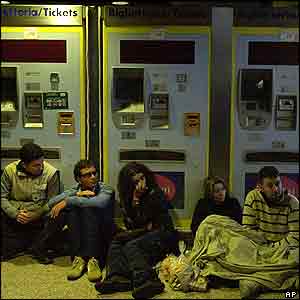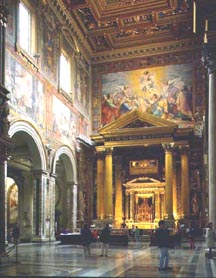|
|
 |
|
Termini Station |
|
written
by mcwilson / 09.17.2005 |
|
|
|
|
|
| <click to type page headline> <use TAB to move to next textbox> |
1 of 1 |
|
| |
The social characteristics of the residents |
| |
| |

|
|
| Map of Esquilino/ Termini area |
|
| |
|
| |

|
|
| People Congregating in Termini |
|
| |
|
| |

|
|
| A Man Resting in Termini |
|
| |
|
In a tour of the area surrounding Termini station, it was evident that many ethnic groups inhabit this area. The Esquilino neighborhood is quite close to the Termini station, and is a well-studied multiethnic neighborhood. The Esquilino area has a large immigrant population of between 15 and 20% living amongst what it primarily a middle class neighborhood. One of the most prevalent nationalities in the Esquilino is the Chinese, who were running mostly clothing stores and restaurants. There were a large percentage of Filipino residents in this neighborhood, but during our tour we saw almost none milling around the area. This was probably an indication of the nature of their employment, which is known to be primarily domestic service. There is a less prevalent population of Bangladeshi, who are more noticeable in the area as they engage in visible economic activity. A small population of Jewish immigrants inhabits this area, which was evidenced by the numerous shops with Jewish names. There is also a small area of the Esquilino that houses a community of more recent immigrants from Nigeria.
We assume that the age of the people living in this area is quite well averaged to middle aged, as the people that we could actually see milling around appeared to be with their family, providing for a fairly even age distribution. These families that we noted were playing in the park, and appeared to live in the area, as we assume that people visit the parks of which they live closest out of convenience. Around the area of the Vittorio Emanuele Park, we noticed a lack of young people shopping or milling around the interior of the park, but an abundance of young people congregating on the exterior of the park along the fence. We weren’t quite sure what this meant, but an obvious explanation would be that the youth of the area are trying to separate themselves from the older inhabitants of this area. We noticed a significant amount of anti-Bush graffiti on the walls of the buildings surrounding Termini, which we presume is the action of young people. This may indicate that the youth in this area are more interested in foreign affairs, or at least more active in demonstrating their position.
On the North Eastern side of Termini station there exists a fairly different neighborhood, which still houses a large immigrant population, but seems to cater more to tourists than the Esquilino. This area contains many Hostels and a few Hotels, which makes sense because it is right in the “dumping ground” for all of the incoming trains at Termini Station. We had a chance to stay in two hostels in this area, one of which was run by a Chinese family, and the other by an American family. These hostels draw in a large number of youth from all over the world, which contributes to the overabundance of youth on this side of the Termini.
|
| |
|
| |
|
| |
The distinctive economic and consumption activity in the neighborhood |
| |
The area directly surrounding the Termini is, as to be expected, composed of many shops geared towards the freshly unloaded tourists. We found many restaurants and clothing stores, street vendors selling purses, flags and other trinkets. Higher prices, grumpier storeowners and the large number of street vendors are all indicative of high tourism and an economy focused on this tourism.
Walking a few blocks away, you will enter the Esquilino neighborhood. Esquilino, literally meaning "outsider", has an economy catering towards its many immigrant residents. In fact, 50% of the Chinese work in the same neighborhood they live, thus creating an ethnic enclave. It is obvious that the Chinese make up a large percentage of residents living here as it is common to see stores with only Chinese Characters -- without any Italian translation. These restaurants are non-traditional in that they do not serve Italian food or sell Italian clothes. We observed many Bangladeshi restaurants and grocery stores with Bangla titles. The prices are very low relative to other central Rome neighborhoods. This information suggests that they are catering to themselves and their own community – more evidence that this is an ethnic enclave (or a composition of different ethnic enclaves).
The central Piazza in Esquilino, Piazza Vittorio Emanuelle II, contains Jewish shops along the west side selling traditional Italian jewelry and clothes. The North and East sides contain shops run by Bangladeshi and Chinese immigrant families. Again, a large influence of the immigrant populations is immediately visible. According to research done by Dr. Mudu, there used to be an age-old market run by non-immigrant groups in the Piazza Vittorio until it was recently moved onto a nearby side street. Today, immigrant groups run forty-two percent of the market. The market still attracts many Romans and is therefore a source of outside income into the community.
In the Laterano neighborhood, one notices a large number of wedding stores, selling dresses and appropriate suits, cheap ties and other marital paraphernalia. Getting closer to San Giovanni, one observes more street vendors selling purses, but at a much lower price (one student observed that the vendor would START the bargaining at ten Euro, rather than the normal forty-five).
|
| |
|
| |
|
| |
Generalizations about the character/culture of the area |
| |
| |

|
|
| San Giovanni in Laterano |
| This famous church is located in Laterano and is open for the public to attend. |
| |
|
In Laterano and Esquilino, fashion and style do not define the neighborhoods, as they seem to do in more centralized parts of Rome. The observational lifestyle is not altogether “hip” or “trendy,” as one would expect to find in nearby areas. Perhaps this is because of the seemingly poorer residents here. Perhaps there is less of an open fusion of styles because Laterano and Esquilino are inhabited by a substantial amount of immigrants who seem to cluster among people of their own culture and open shops catered to their own lifestyle.
These areas are therefore not incredibly stylish. There are either very few fashionable shopping locales, places to “hang out,” and night clubs, or they are just well hidden to the critical observer. However, the area is also quite devoid of young people. This leads us to conclude that one of two general phenomena may be occurring. Young people could be staying in (or going elsewhere) because there is not much to do, or the area does not cater to young people because there are not many young people to accommodate.
In an effort to encourage socialization and community involvement, the area has become a location of a deliberate Social Center, offering public entertainment such as outdoor films. There are also currently parks open to the public, which seem to draw in a lot of people. While it is not a characteristically “artsy” part of Rome, the effects of the Social Center may prove to benefit the artistic interests of the residents.
Additionally there are a number of public art pieces located throughout these neighborhoods. There is an art museum that we passed, but it would have been nearly impossible to tell that it was any different from any other building or apartment complex had our tour guide not told us so, because there are no clear markings to distinguish it from anything else. There is also a museum of musical instruments here, an interesting and quite unique characteristic of the area. Most of the public art that we passed has religious connotations, some of which are defaced (as in one park’s monk sculpture that had been decorated with graffiti). Occurrences such as these skew our understanding of the extent of piety that can be expected here.
However, two of Rome’s most well-known churches, the Santa Maria Maggiore, and San Giovanni in Laterano, are located here, among others. We passed through the latter, which proved to be quite impressive, and observed a number of people praying, as well as monks and nuns passing by outside. A man could be seen kissing the foot of a bronze wall sculpture at the side of the church. Yet there is not enough evidence to convince us that the area is wholly religious.
In a final note, the cultural dynamics around Termini Station are quite different than those around Laterano and Esquilino. The area is characterized by hostels and hotels, restaurants, not as many churches or trendier shops, but a noticeable stream of people passing through, of course because of the train station; in fact, the diversity of this area seems to arise from the tourists filtering through. Yet it is difficult to generalize about the people in any of these areas as a whole, because there is an overall lack of community and logical connection between groups of inhabitants.
|
| |
|
| |
|
|
 |
|




